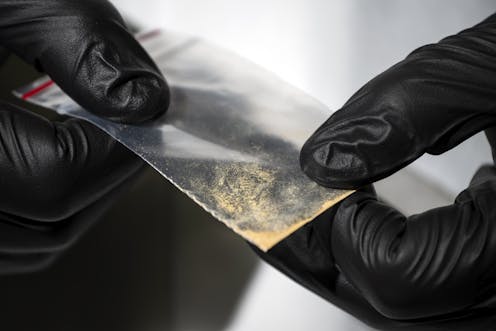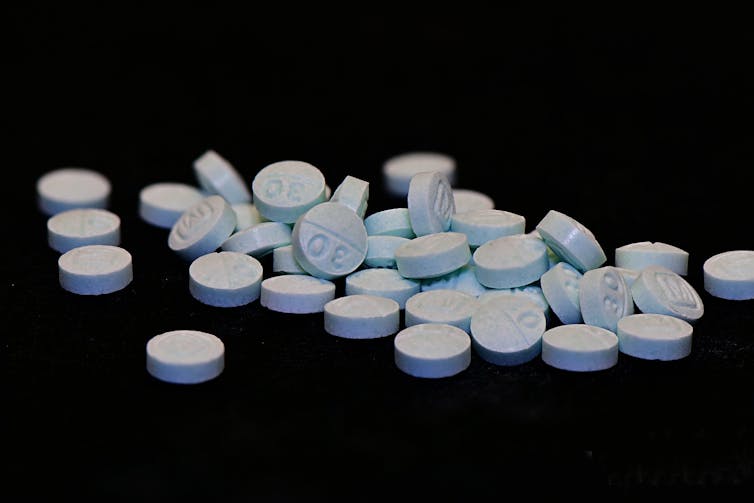Nitazenes found in 5 overdose deaths in Philly – here’s what they are and why they’re so deadly
Initially developed in the 1950s, nitazenes are a type of synthetic opioid that has reappeared in Philadelphia’s street drug supply.

The Philadelphia Medical Examiner’s Office found that nitazenes, a synthetic opioid up to 40 times more powerful than fentanyl, were connected to at least five overdose deaths in Philadelphia in the past two years.
The nitazene deaths are just a small part of a much bigger problem. A record 1,413 people died from overdoses on illicit drugs in the city in 2022, the latest year for which complete data is available. The vast majority involved other forms of opioids, including heroin, fentanyl and xylazine, also known as “tranq.”
The Conversation interviewed Dr. Christopher Holstege, a professor of emergency medicine and pediatrics at the University of Virginia School of Medicine and director of the Blue Ridge Poison Center, about this emerging threat. He explains what nitazenes are and why they’re so deadly.
What are nitazenes?
Nitazenes are a class of synthetic opioids that contains more than 20 unique compounds, including isotonitazene, which was first identified in 2019 and is known on the streets as ISO. It also includes protonitazene, metonitazene and etonitazene.
Nitazenes are psychoactive substances, or “designer drugs,” that aren’t controlled by any laws or conventions but pose significant health risks to the public. These substances have recently surfaced as illegal street drugs.
Researchers have relatively little information on how the human body reacts to nitazenes because the drugs have never gone through clinical trials. But lab tests show certain nitazenes could be hundreds to thousands of times more potent than morphine and 10 to 40 times stronger than fentanyl.
The U.S. Drug Enforcement Agency has classified many formulations of nitazenes as Schedule 1 drugs under the Controlled Substances Act, meaning they have no medical use and have a high risk of abuse.
When were nitazenes first developed?
Nitazenes were initially developed in the 1950s by the pharmaceutical research laboratories of the Swiss chemical company CIBA Aktiengesellschaft. It synthesized numerous substances in the drug class to be used as painkillers.
However, nitazenes were never approved by the U.S. Food and Drug Administration for medical use in humans. They were nearly forgotten outside of specialized research circles until they reemerged as street drugs in 2019. As law enforcement has cracked down on other drugs such as fentanyl, illegal labs have used historical pharmacology research to formulate analogs of nitazenes as street drugs.
Since 2019, at least six formulas have come from the original patent, but others, are brand new. Specialized lab testing is required to identify nitazenes in toxicology samples, and fentanyl test strips can’t detect nitazene analogs.
But since first being detected, nitazenes have been blamed for 200 drug-related overdose deaths in Europe and the United States. Although nitazenes are now identified as illegal street drugs in numerous countries, many medical providers aren’t even aware they exist.

What types of nitazenes are showing up on the streets?
Nitazene first appeared in 2019 in the Midwest as a white powdery substance similar to cocaine. It later appeared on the streets of Washington, D.C., as yellow, brown and white powders. Since 2022, the DEA has found other types of nitazenes in both powder and blue tablet forms.
Nitazenes are also mixed with other street drugs such as heroin and fentanyl, and with fake oxycodone pills, without users knowing it.
The Justice Department has indicted several companies in China, alleging that they ship the raw chemicals to make nitazenes to Mexico and the U.S., where they get mixed by cartels and traffickers, then distributed on the streets.
What are signs of a nitazene overdose?
The toxic effects of nitazene resemble those associated with other classic opioids such as morphine and fentanyl and include small pupils and slowing of the respiratory and central nervous systems, which can lead to death.
Because of the potency of the nitazenes, symptoms can develop rapidly after someone is exposed, killing them before they can get medical care.
Does naloxone counteract the effects of overdose?
Naloxone, commonly known as Narcan, is reportedly effective in reversing overdoses due to nitazene, but larger and multiple doses might be required.
This is an updated version of an article originally published on Feb. 15, 2024.
Christopher P. Holstege does not work for, consult, own shares in or receive funding from any company or organization that would benefit from this article, and has disclosed no relevant affiliations beyond their academic appointment.
Read These Next
West Coast levee failures show growing risks from America’s aging flood defenses
Levees protect more than 7 million buildings in the US today, yet they got a D-plus grade in 2025. A…
LA fires showed how much neighborliness matters for wildfire safety – schools can do much more to te
Managing fire risk is about more than regulations and rules. It’s also about caring for neighbors…
The ‘sacred’ pledge that will power the relaunch of far-right militia Oath Keepers
Founder Stewart Rhodes says he will relaunch the group, serving as an important outlet for thousands…






